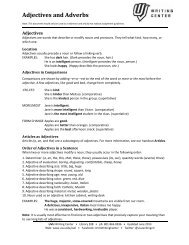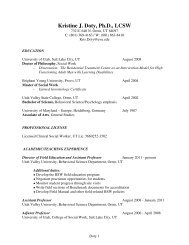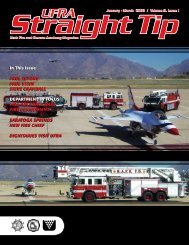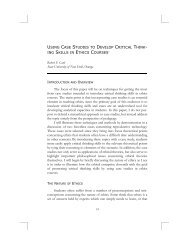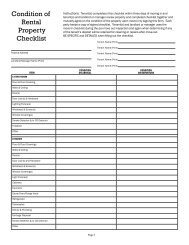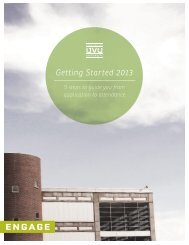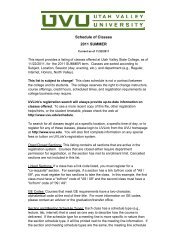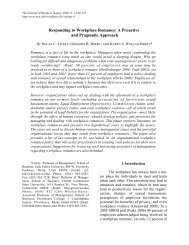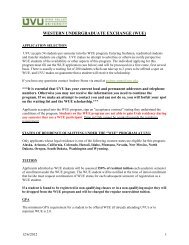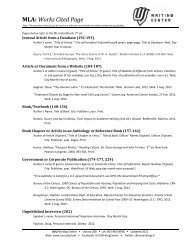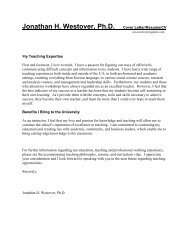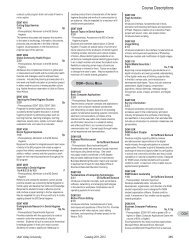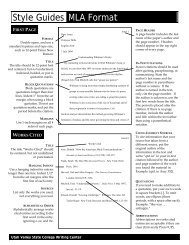Type of Assessment - uvu.edu
Type of Assessment - uvu.edu
Type of Assessment - uvu.edu
Create successful ePaper yourself
Turn your PDF publications into a flip-book with our unique Google optimized e-Paper software.
<strong>Assessment</strong> Resources<br />
<strong>Assessment</strong> Resources<br />
Learning Outcomes<br />
How to write a learning outcome<br />
Digital Education Strategies. (2010). Writing effective learning objectives. Unpublished<br />
Manuscript The Chang School, Ryerson University , Retrieved from<br />
http://de.ryerson.ca/portals/de/assets/resources/Learning_Objectives.pdf<br />
Repko, A. (2011). Stephen f. Austin State University rubric assessment resource page<br />
examples <strong>of</strong> rubrics <strong>of</strong> both discipline-specific and college-wide outcomes are<br />
provided.. Unpublished manuscript, <strong>Assessment</strong>, University <strong>of</strong> Texas Arlington, USA.<br />
Stanford. (2012) <strong>Assessment</strong> Tools. Stanford University, Unpublished Manuscript, Palo<br />
Alto USA. Retrieved from http://www.stanford.<strong>edu</strong>/dept/presprovost/irds/assessment/downloads/CLO.pdf<br />
<strong>Type</strong>s <strong>of</strong> learning outcomes<br />
Beterlein, S., Davis, D., & Apple, D. (2011). Learning outcomes. Retrieved from<br />
http://www.webs1.uidaho.<strong>edu</strong>/ele/scholars/practices/instructional_design/Resources<br />
Books<br />
University <strong>of</strong> Utah’s Measurable learning outcomes grid. (2010). Unpublished manuscript, University <strong>of</strong><br />
Utah,Salt Lake City, UT, USA . Retrieved from<br />
http://studentaffairs.utah.<strong>edu</strong>/assessment/documents/planning/learning-reconsidered-table.pdf<br />
Albert , A. (2009). Assessing student learning outcomes in the college environment:<br />
Effective methods <strong>of</strong> measuring general <strong>edu</strong>cation programs' core learning outcomes at urban and<br />
metropolitan universities, VDM Verlag.<br />
Bigg, J., & Tang, C. (2011). Teaching for quality learning at university (Society for<br />
Research into Higher Education). (4 ed.). New York, NY: McGraw-Hill Education.<br />
New Leadership Alliance for Student Learning and Accountability. (2012). Assuming Quality: An<br />
Institutional Self-<strong>Assessment</strong> Tool for Excellent Practice in Student Learning Outcomes <strong>Assessment</strong>.<br />
Washington DC, DC: New Leadership Alliance for Student Learning and Accountability.<br />
Saunders, L. (2011). Information literacy as a student learning outcome: The perspective<br />
<strong>of</strong> institutional accreditation. Unpublished Manuscript, Santa Barbara, CA: ABC-CLIO, LLC.<br />
Shavelson, R. (2009). Measuring college learning responsibly: Accountability in a new<br />
era. Unpublished Manuscript. Stanford CA: Stanford University Press.<br />
Suskie, L., Banta, T., & Albert, A. (2009). Assessing student learning outcomes in<br />
the college environment: Effective methods <strong>of</strong> measuring general <strong>edu</strong>cation programs' core learning<br />
at urban and metropolitan universities. San Francisco, CA: John Wiley & Son Inc.<br />
Walvoord, B., & Banta, T. (2010). <strong>Assessment</strong> clear and simple: A practical guide for<br />
institutions, departments, and general <strong>edu</strong>cation. (2 ed.). San Francisco, CA: John Wiley & Son Inc.<br />
Michelle Baron, Academic <strong>Assessment</strong> Specialist, 801-863-8226, michelle.baron@<strong>uvu</strong>.<strong>edu</strong><br />
1
<strong>Assessment</strong> Resources<br />
Rubrics<br />
Ten Sigma (2009). <strong>Type</strong>s <strong>of</strong> rubrics. Retrieved from<br />
http://www.tensigma.org/rubrics/about/rubrics_rb2.html<br />
Association <strong>of</strong> American Colleges and Universities (AAC&U) VALUE Rubrics:<br />
http://www.aacu.org/value/rubrics/index.cfm<br />
Angelo, T. A., & Cross, K. P. (1993). Classroom <strong>Assessment</strong> Techniques: A Handbook for<br />
College Teachers (2nd ed.). Jossey-Bass<br />
Arter, J., & McTighe, J. (2001). Scoring rubrics in the classroom: Using performance criteria<br />
for assessing and improving student performance (experts in assessment series). Thousand Oaks, CA:<br />
Corwin Press Inc: Sage Publication Company.<br />
Burke, K. (2011). From standards to rubrics in six steps: Tools for assessing student learning.<br />
(3 ed.). Thousand Oaks, CA: Corwin: Sage Publication Company.<br />
Quinlan, A. (2011). A complete guide to rubrics: <strong>Assessment</strong> made easy for teachers, KDCollege.<br />
Esrover Road, Plymouth, UK: Rowman & Littlefield Education<br />
Rhodes, T. (2010). Assessing Outcomes and Improving Achievement: Tips and Tools for Using<br />
Rubrics. Washington, DC: Association <strong>of</strong> American Colleges and Universities.<br />
Rubric library . (2012). Unpublished manuscript, <strong>Assessment</strong>, Fresno State , San Franscio , CA,<br />
USA. Retrieved from http://www.fresnostate.<strong>edu</strong>/academics/oie/assessment/rubric.html<br />
Schreyer Institute for Teaching Excellence . (2007). The basics <strong>of</strong> rubrics. Unpublished manuscript,<br />
Schreyer Institute, Penn State, 16802, PA, USA.<br />
Retrieved from http://www.schreyerinstitute.psu.<strong>edu</strong>/pdf/rubricbasics.pdf<br />
Stevens, D., & Levi, A. (2005). Introduction to rubrics: An assessment tool to save grading time,<br />
convey effective feedback, and promote student learning . Sterling, VI: Stylus Publishing, LLC.<br />
Suskie, L. (2009). Assessing student learning: A common sense guide. (2nd ed.). San Francisco,<br />
CA: John Wiley & Sons, Inc.<br />
RCampus' iRubric: A free online resource that helps create rubrics in a collaborative learning<br />
environment. Retrieved from: http://www.rcampus.com/indexrubric.cfm<br />
RubiStar: A free online website tool developed through the Advanced Learning Technologies<br />
(ALTEC) project at the University <strong>of</strong> Kansas Center for Research on Learning helps visitors create rubrics.<br />
Retrived from: http://rubistar.4teachers.org/index.php<br />
Stephen F. Austin State University Rubric <strong>Assessment</strong> Resource Page: Examples <strong>of</strong> rubrics <strong>of</strong><br />
both discipline-specific and college-wide outcomes are provided. Retrieved from:<br />
http://www.sfasu.<strong>edu</strong>/assessment/rubrics.asp<br />
Michelle Baron, Academic <strong>Assessment</strong> Specialist, 801-863-8226, michelle.baron@<strong>uvu</strong>.<strong>edu</strong><br />
2
<strong>Assessment</strong> Resources<br />
<strong>Type</strong> <strong>of</strong> <strong>Assessment</strong><br />
Edutopia. (2012). What are some types <strong>of</strong> assessment? Retrieved from<br />
http://www.<strong>edu</strong>topia.org/assessment-guide-description<br />
Practicum handbook; A guide for site supervisors.(2012). Unpublished manuscript, Rollins<br />
School <strong>of</strong> Public Health, Emory, Atlanta, Georgia, USA. Retrieved from<br />
http://cfusion.sph.emory.<strong>edu</strong>/PracticumProposal/docs/PracticumGuide_Supv.pdf<br />
Epstein, M. L., Lazarus, A. D., Calvano, T. B., Matthews, K. A. et al. (2002). Immediate<br />
feedback assessment technique promotes learning and corrects inaccurate first responses. The psychological<br />
Record. 52, 187-201.<br />
Hanna, G.S., & Dettmer, P.A. (2004). <strong>Assessment</strong> for effective teaching: Using context-adaptive<br />
planning. Boston, MA: Pearson A&B. Retrieved from<br />
http://www.niu.<strong>edu</strong>/facdev/resources/guide/assessment/formative%20<br />
and_summative_assessment.pdf<br />
Higgins, E. & and Tatham, L. (2003). Assessing by multiple choice question (MCQ) tests at<br />
Manchester Metropolitan University. Learning and Teaching in Action. 2(1).<br />
Iddekinge, C. H., Raymark, P.H, Eidson, C.E., & Attenweiler, W.J. (2004) What Do Structure<br />
Selection Interviews Really Measure? The construct Validity <strong>of</strong> Behavior Description Interviews. Human<br />
Performance 17(1), 71-93.<br />
Kuechler, W. L. & Simkin. M. G. (2003). How Well Do Multiple Choice Tests Evaluate Student<br />
Understanding in Computer Programming Classes? Journal <strong>of</strong> Information Systems<br />
Education. West Lafayette: Winter 2003. Vol. 14, Iss. 4; p. 389<br />
Roberts, T.S. (2006). The Use <strong>of</strong> Multiple Choice Tests for Formative and Summative<br />
<strong>Assessment</strong>. Conference in Research in Practice in Information Technology. Hobart, Tasmania, Australia:<br />
Vol 52.<br />
University Texas Arlington. (2012). Advantages and disadvantages <strong>of</strong> various assessment methods. Retrieved from<br />
http://www.uta.<strong>edu</strong>/irp/unit_effectiveness_plans/assets/AssessMethods.pdf<br />
UW Teachers Association Conference on Teaching & Learning: Giving Students Feedback and Assigning Grades.<br />
(2003). <strong>Type</strong>s <strong>of</strong> assessment. Retrieved from<br />
http://jtenlen.drizzlehosting.com/workshop/workshop3.html<br />
Michelle Baron, Academic <strong>Assessment</strong> Specialist, 801-863-8226, michelle.baron@<strong>uvu</strong>.<strong>edu</strong><br />
3
<strong>Assessment</strong> Resources<br />
<strong>Assessment</strong> Plans<br />
How to assess assessments<br />
Why assessment?. (2010). Unpublished manuscript, <strong>Assessment</strong>, University <strong>of</strong> Connecticut , Retrieved<br />
from http://assessment.uconn.<strong>edu</strong>/why/index.html<br />
<strong>Assessment</strong> Handbook (2005). UCF Academic Program <strong>Assessment</strong> Handbook, University <strong>of</strong> Central<br />
Florida, UCG retrieved from http://oeas.ucf.<strong>edu</strong>/doc/acad_assess_handbook.pdf<br />
Nichols J, & Nichols K. (2000). The Departmental Guide and Record Book for Student<br />
Outcomes <strong>Assessment</strong> and Institutional Effectiveness. NY: Agathon Press.<br />
Stanford. (2012) <strong>Assessment</strong> Tools. Stanford University, Palo Alto USA. Retrieved from<br />
http://www.stanford.<strong>edu</strong>/dept/pres-provost/irds/assessment/downloads/AM.pdf<br />
Purpose <strong>of</strong> creating an assessment plan:<br />
<strong>Assessment</strong> handbook: Creating assessment plans (2011).<br />
Michigan State, MI, USA. Retrieved from<br />
http://www.engin.umich.<strong>edu</strong>/teaching/assess_and_improve/handbook/plans.html<br />
Stanford. (2012) <strong>Assessment</strong> Tools. Stanford University, Palo Alto USA. Retrieved from<br />
http://www.stanford.<strong>edu</strong>/dept/pres-provost/irds/assessment/tools.html<br />
Stanford. (2012) <strong>Assessment</strong> Tools. Stanford University, Palo Alto USA. Retrieved from<br />
http://www.stanford.<strong>edu</strong>/dept/pres-provost/irds/assessment/downloads/<strong>Assessment</strong>_process.pdf<br />
Overall <strong>Assessment</strong><br />
Allen, M. J. (2004). Assessing Academic Programs in Higher Education. Anker Publishing Company,<br />
Bolton MA.<br />
Anderson, L. W., Krathwohl, D. R., Airasian, P. W., Cruikshank, K. A., Mayer, R. E.,<br />
Pintrich, P. R., Raths, J., et al. (2000). A Taxonomy for Learning, Teaching, and Assessing: A<br />
Revision <strong>of</strong> Bloom’s Taxonomy <strong>of</strong> Educational Objectives, Complete Edition. Allyn & Bacon.<br />
Angelo, T. A., & Cross, K. P. (1993). Classroom <strong>Assessment</strong> Techniques: A Handbook<br />
for College Teachers (2nd ed.). Jossey-Bass.<br />
Astin, A. W., & Antonio, A.L. (2012). <strong>Assessment</strong> for Excellence: The Philosophy and<br />
Practice <strong>of</strong> <strong>Assessment</strong> and Evaluation in Higher Education (2nd ed.). Rowman & Littlefield<br />
Publishers.<br />
Earl, L. M. (2003). <strong>Assessment</strong> As Learning: Using Classroom <strong>Assessment</strong> to Maximize<br />
Student Learning (1st ed.). Corwin Press.<br />
Gabriel, K.F. (2008). Teaching unprepared students: Strategies for promoting success and retention in<br />
higher <strong>edu</strong>cation. Sterling, VA: Stylus<br />
Garrison, R. D., & Vaughan, N. D. (2007). Blended learning in higher <strong>edu</strong>cation: Framework, principles,<br />
and guidelines. San Francisco: Jossey Bass<br />
Michelle Baron, Academic <strong>Assessment</strong> Specialist, 801-863-8226, michelle.baron@<strong>uvu</strong>.<strong>edu</strong><br />
4
<strong>Assessment</strong> Resources<br />
Hickmott, J. (2009). Measuring student performance: Using appropriate evaluation tools.<br />
In Perozzi, B. (Ed.). Enhancing student learning through college employment.<br />
Bloomington, IN: Association <strong>of</strong> College Unions International.<br />
Kuh, G. D. (2008). High impact <strong>edu</strong>cational practices: What they are, who has access to them, and why they<br />
matter. Washington, D. C.: AAC&U.<br />
Maki, P. L. (2010). Assessing for Learning: Building a Sustainable Commitment Across the Institution<br />
(Second ed.). Stylus Publishing.<br />
Mann, J., Permaul, N., & Perozzi, B. (2009). A multiple case study <strong>of</strong> two California<br />
universities. In Perozzi, B. (Ed.). Enhancing student learning through college<br />
employment. Bloomington, IN: Association <strong>of</strong> College Unions International.<br />
Middle States Commission on Higher Education. (2007). Student Learning <strong>Assessment</strong>:<br />
Options and Resources. (2nd ed.). Philadelphia, PA: Middle States Commission<br />
on Higher Education.<br />
Perozzi, B., Kappes, J., & Santucci, D. (2009). Learning outcomes and student<br />
employment programs. In Perozzi, B. (Ed.). Enhancing student learning through<br />
college employment. Bloomington, IN: Association <strong>of</strong> College Unions International.<br />
Sambell, K., McDowell, L., & Montgomery, C. (2012). <strong>Assessment</strong> for Learning in<br />
Higher Education. Routledge.<br />
Comprehensive academic assessment program. (2010). Informally published manuscript,<br />
<strong>Assessment</strong> , Southwest College <strong>of</strong> Naturopathic Medicine and Health Sciences , Temple, AZ, USA .<br />
Retrieved from http://www.scnm.<strong>edu</strong>/images/stories/Comprehensive Academic <strong>Assessment</strong><br />
Program.pdf<br />
Suskie, L. (2009). Assessing Student Learning: A Common Sense Guide (2nd ed.).<br />
Jossey-Bass.<br />
Tagg, J. (2003). The Learning Paradigm College (1st ed.). Jossey-Bass.<br />
Walvoord, B. E. (2010). <strong>Assessment</strong> Clear and Simple: A Practical Guide for<br />
Institutions, Departments, and General Education (2nd ed.). Jossey-Bass.<br />
Michelle Baron, Academic <strong>Assessment</strong> Specialist, 801-863-8226, michelle.baron@<strong>uvu</strong>.<strong>edu</strong><br />
5
<strong>Assessment</strong> Resources<br />
Mission Statements<br />
Department / team . (2012). Retrieved from<br />
http://www.missionstatements.com/team_mission_statements.html<br />
Diamond, R. (1999). Aligning faculty rewards with institutional mission: Statements, policies & guidelines<br />
(Syracuse University). Bolton, MA : Anker Publishing Company, Inc.<br />
How to write a mission Statement<br />
Stanford. (2012) <strong>Assessment</strong> Tools. Stanford University, Palo Alto USA. Retrieved from<br />
http://www.stanford.<strong>edu</strong>/dept/pres-provost/irds/assessment/downloads/mission_stmt.pdf<br />
Özdem, G. (2011). An Analysis <strong>of</strong> the Mission and Vision Statements on the Strategic<br />
Plans <strong>of</strong> Higher Education Institutions. Educational Sciences: Theory & Practice, 11(4), 1887-1894.<br />
Palmer T.B., & Short, J.C. (2008). Mission Statements in U.S. Colleges <strong>of</strong> Business: An<br />
Empirical Examination <strong>of</strong> Their Content With Linkages to Configurations and Performance. Academy Of<br />
Management Learning & Education, 7(4), 454-470. doi:10.5465/AMLE.2008.<br />
Taylor, R. (2011). The mission statement: A framework for developing an effective organizational mission<br />
statement in 100 words or less . (2 ed.).<br />
Data Collection<br />
Johnston, T. C. (2010). Data without tears: How to write measurable <strong>edu</strong>cational goals and<br />
collect meaningful data . Research Press.<br />
Pearson, R. W. (2010). Statistical persuasion: How to collect, analyze, and present<br />
data. Accurately, honestly, and persuasively. Thousand Oaks, CA: Sage Publications, Inc.<br />
Shea, M., Murray, R., & Harlin, R. (2005). Drowning in data?: How to collect, organize, and<br />
document student performance. Heinemann Corp.<br />
Stawarski, C., & Phillips, P. P. (2008 ). Data collection: Planning for and collecting all types <strong>of</strong> data<br />
(measurement and evaluation series). (1 ed.). Pfeiffer.<br />
Michelle Baron, Academic <strong>Assessment</strong> Specialist, 801-863-8226, michelle.baron@<strong>uvu</strong>.<strong>edu</strong><br />
6
<strong>Assessment</strong> Resources<br />
Analyzing Data<br />
Stanford, Linn & Mille, 2005.<br />
http://www.stanford.<strong>edu</strong>/dept/pres-provost/irds/assessment/downloads/analyze.pdf<br />
Temple University<br />
http://www.temple.<strong>edu</strong>/provost/aaa/other_accrediting/documents/resultsandtheiruses.pdf<br />
Using assessment effectively. (2011). Informally published manuscript, Office <strong>of</strong> Teaching &<br />
Learning, University od Denver , Denver, CO. Retrieved from http://ctl.du.<strong>edu</strong>/teaching-resources/assessingstudent-learning/using-assessment-effectively<br />
Books<br />
Bernard, H., & Ryan, G. (2009). Analyzing qualitative data: Systematic approaches . Thousand Oaks, CA:<br />
Sage Publications, Inc.<br />
Blaikie, N. (2003). Analyzing quantitative data: From description to explanation.<br />
Thousand Oaks, CA: SAGE Publications.<br />
Maxwell, S., & Delaney, H. (2003). Designing experiments and analyzing data: A model<br />
comparison perspective, . (2 ed.). New Jersey : Routledge Academic.<br />
Moore, B. (2011). I have the data now what? Analyzing data and making instructional<br />
changes. Eye on Education inc.<br />
Middaugh, M. (2010). Planning and assessment in higher <strong>edu</strong>cation: Demonstrating<br />
institutional effectiveness. San Francisco, CA: John Wiley & Son Inc.<br />
Michelle Baron, Academic <strong>Assessment</strong> Specialist, 801-863-8226, michelle.baron@<strong>uvu</strong>.<strong>edu</strong><br />
7
<strong>Assessment</strong> Resources<br />
How to close the loop<br />
Closing the Loop<br />
King, L. J. (2010). Closing the loop in assessment . Retrieved from<br />
http://www.sfasu.<strong>edu</strong>/assessment/pdf/closing-the-loop-in-assessment.pdf<br />
Murphy, J. (2010). The <strong>edu</strong>cator's handbook for understanding and closing achievement gaps.<br />
Thousand Oaks, CA: Corwin Press<br />
Myers, W. (2006 ). Closing the assessment loop: Nurturing healthy, on-going self-evaluation in<br />
theological schools. Chicago : Chicago Theological Seminary dba Exploration Press.<br />
Reed, T., Levin, J., & Malandra, G. (2011, October ). Closing the assessment loop by design.<br />
Retrieved from http://www.changemag.org/Archives/Back Issues/2011/September-October 2011/closingthe-full.html<br />
Raymond , Z. (2011). Closing the loop. Unpublished Manuscript. Retrieved from<br />
http://www.hamline.<strong>edu</strong>/learning-outcomes/closing-loop.html<br />
Covino, W. (2011). Closing the loop: When assessment becomes meaningful for<br />
faculty. Retrieved from wascarc.org/program/closing-loop-when-assessment-becomes-meaningful-faculty<br />
Examples <strong>of</strong> people who closed the loop<br />
Banta, T. W., & Blaich, C. (2011). Closing the <strong>Assessment</strong> Loop. Change, 43(1), 22-27.<br />
doi:10.1080/00091383.2011.538642<br />
Hatzipanagos, S. (2008). Closing the loop: Identifying effective formative assessment practices<br />
and feedback processes that empower the learner and enhance the student experience in open and distance<br />
learning. Unpublished manuscript, King's Learning Institute , Kings College , Strand, London. Retrieved<br />
from http://cdelondon.files.wordpress.com/2011/01/tra2hatzipanagosfinalreport-_cde-report_.pdf<br />
Klemic, G. G., & Lovero, E. (2011). Closing the Loop: Assessing SLOs for Quantitative and<br />
Qualitative Models in Business Courses. <strong>Assessment</strong> Update, 23(1), 9-10.<br />
Scott, S., Issa, T., & Issa, T. (2008). Closing the Loop: The Relationship between Instructor-<br />
reflective Practice and Students' Satisfaction and Quality Outcomes. International<br />
Journal <strong>of</strong> Learning, 15(3), 109-120.<br />
Michelle Baron, Academic <strong>Assessment</strong> Specialist, 801-863-8226, michelle.baron@<strong>uvu</strong>.<strong>edu</strong><br />
8



